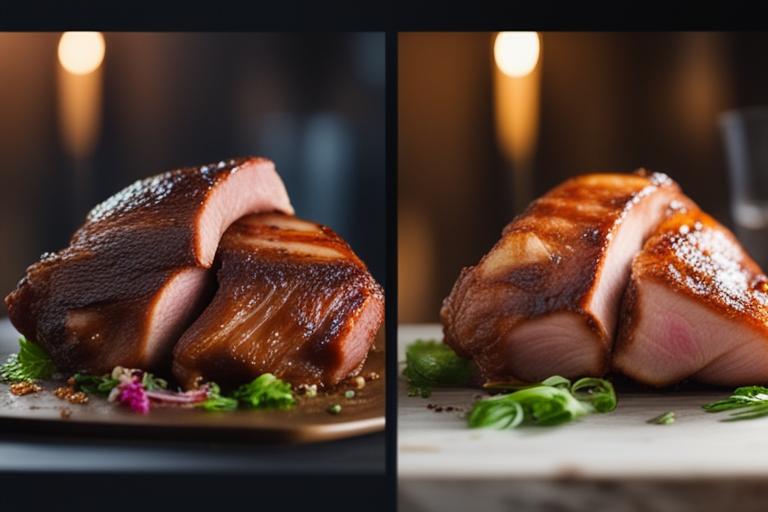If you’re a fan of BBQ, you’ve probably come across pork shoulder and pork butt. So, what is the difference between these two cuts of meat, and which one is best for your next BBQ?
Choosing Between Pork Shoulder and Pork Butt for BBQ
Learn the differences between pork shoulder and pork butt, including flavor profile, texture, cooking methods, recipe ideas, and pricing and availability.
– Pork shoulder is from the upper part of the shoulder and is typically leaner and easier to slice.
– Pork butt is from the upper part of the shoulder and is fattier and ideal for slow-cooking recipes like pulled pork and stews.
– Factors like cooking method, seasoning, and marinating can impact flavor and texture.
Pork Shoulder and Pork Butt: An Overview
Pork shoulder and pork butt are both cuts of meat from the pig’s shoulder. However, pork shoulder comes from the upper part of the pig’s front leg, while pork butt comes from the upper part of the shoulder. Despite their names, neither of these cuts comes from the pig’s rear end.
The key difference between the two is their fat content. Pork shoulder has a higher fat content, making it more forgiving to cook, while pork butt is leaner and can be more challenging to cook.

Flavor and Texture Comparison
When it comes to flavor and texture, pork shoulder and pork butt have some distinct differences. Pork shoulder has a richer flavor and tends to be more tender than pork butt. Pork butt, on the other hand, has a firmer texture and a slightly milder flavor.
Factors such as the pig’s diet and the cooking method used can influence the flavor and texture of both cuts. Using a dry rub or marinade can enhance the flavor of your pork shoulder or pork butt.
Nutritional Value and Health Benefits
Pork shoulder and pork butt are both excellent sources of protein, vitamins, and minerals. A 3-ounce serving of pork shoulder contains approximately 22 grams of protein, while pork butt contains about 24 grams of protein. Both cuts are also rich in vitamins B6 and B12, zinc, and selenium.
While pork shoulder has a higher fat content, most of it is monounsaturated and polyunsaturated fats, which are considered healthy fats. These fats can help reduce LDL (bad) cholesterol levels and decrease the risk of heart disease.

Cooking Methods
Pork shoulder and pork butt can be cooked using a variety of methods such as smoking, roasting, and braising. However, the best method for each cut may vary depending on your preferences and the specific recipe you’re using.
If you’re cooking pork shoulder, smoking or roasting are great methods to consider. Pork shoulder can be cooked low and slow, allowing the fat to melt and infuse the meat with flavor. If you’re cooking pork butt, braising or smoking may be the best method. Braising involves cooking the meat in liquid, which helps keep it moist and tender.
Regardless of which method you choose, it’s important to keep an eye on the internal temperature of the meat to ensure it’s cooked to a safe temperature. The United States Department of Agriculture (USDA) recommends an internal temperature of 145°F for pork.

Recipe Ideas
Now that you know how to cook pork shoulder and pork butt, it’s time to get creative in the kitchen. Here are some recipe ideas to get you started:
Pork Butt Recipes
- Pulled Pork: Slow-cook pork butt in a smoker or oven until it’s tender and falling apart. Shred the meat and serve it on a bun with your favorite BBQ sauce.
- Carnitas: Cut pork butt into small pieces and cook it in a Dutch oven until it’s crispy on the outside and tender on the inside. Serve it in tacos with avocado, cilantro, and lime.
- Barbecue Ribs: Smoke pork butt until it’s cooked through, then cut it into rib-sized pieces. Coat the ribs in your favorite BBQ sauce and grill them until they’re caramelized.
Pork Shoulder Recipes
- Pork Roasts: Rub pork shoulder with a dry rub and roast it in the oven until it’s tender and juicy. Serve it with roasted vegetables and mashed potatoes for a classic comfort food meal.
- Stews: Cube pork shoulder and cook it in a stew with potatoes, carrots, and onions. Add your favorite herbs and spices to create a delicious and comforting meal.
- Braised Dishes: Braised pork shoulder is a classic dish that’s perfect for cooler weather. Cook it in a Dutch oven with red wine, tomatoes, and herbs until it’s tender and flavorful.

Pricing and Availability
Pork shoulder is typically more readily available than pork butt. However, the cost of each cut can vary depending on a variety of factors, including the region you live in, the time of year, and the quality of the meat.
To find the best deals on pork shoulder and pork butt, consider shopping at a local butcher or meat market. These retailers often offer high-quality meats at competitive prices and may be able to help you find the perfect cut for your needs.
Case Study: Choosing the Right Cut for a BBQ Competition
As a competitive BBQ chef, choosing the right cut of meat can make or break your chances of winning. That’s why when John Smith signed up for his first BBQ competition, he spent weeks researching which cut of pork to use for his pulled pork recipe.
After reading countless articles and watching hours of YouTube videos, John decided to go with pork shoulder. It had a slightly higher fat content than pork butt, which he believed would give his pulled pork a richer flavor and more tender texture.
John spent the next few weeks perfecting his recipe and honing his cooking techniques. He slow-cooked the pork shoulder for hours on end, using a combination of applewood and hickory chips to infuse the meat with a smoky flavor.
On the day of the competition, John nervously presented his pulled pork to the judges. He held his breath as they took their first bites, hoping that all his hard work had paid off.
To his relief, the judges were blown away by the flavor and texture of his pulled pork. They praised him for his choice of meat, saying that the pork shoulder’s higher fat content had indeed given the meat a richer flavor and more tender texture.
In the end, John’s pulled pork took first place in the competition. He knew that his choice of meat had played a big role in his success, and he was grateful for all the research and practice he had put into perfecting his recipe.
When it comes to BBQ competitions, every detail matters. And for John, choosing the right cut of meat was one of the most important decisions he made.
Conclusion
Pork shoulder and pork butt are both delicious cuts of meat that are perfect for BBQ and other cooking applications. While they have some differences in flavor, texture, and cooking methods, both cuts can be used to create a wide range of delicious meals.
When choosing between pork shoulder vs pork butt, consider your preferences and the specific recipe you’re using. With a little experimentation and practice, you’ll be able to create mouth-watering dishes that showcase the unique flavors and textures of these two amazing cuts of meat.
| Cooking Method | Pork Shoulder | Pork Butt |
|---|---|---|
| Smoking | Great | Good |
| Roasting | Great | Good |
| Braising | Good | Great |
| Grilling | Good | Good |
Questions
What is the difference between pork shoulder and pork butt?
Pork shoulder comes from the upper part of the shoulder while pork butt comes from the lower part.
Who uses pork shoulder vs pork butt?
Chefs and home cooks use both cuts for slow-cooking, smoking, and roasting.
How should I cook pork shoulder or pork butt?
Slow cook pork shoulder or pork butt to achieve tender and juicy meat.
What if I can’t find pork shoulder or pork butt at the store?
Other cuts like pork loin or pork belly can be used as an alternative.
How long does it take to cook pork shoulder or pork butt?
It takes several hours to cook pork shoulder or pork butt, depending on the cooking method.
Isn’t pork shoulder or pork butt high in fat and calories?
While these cuts are fatty, they are also packed with protein and flavor when cooked properly.
Follow us!!